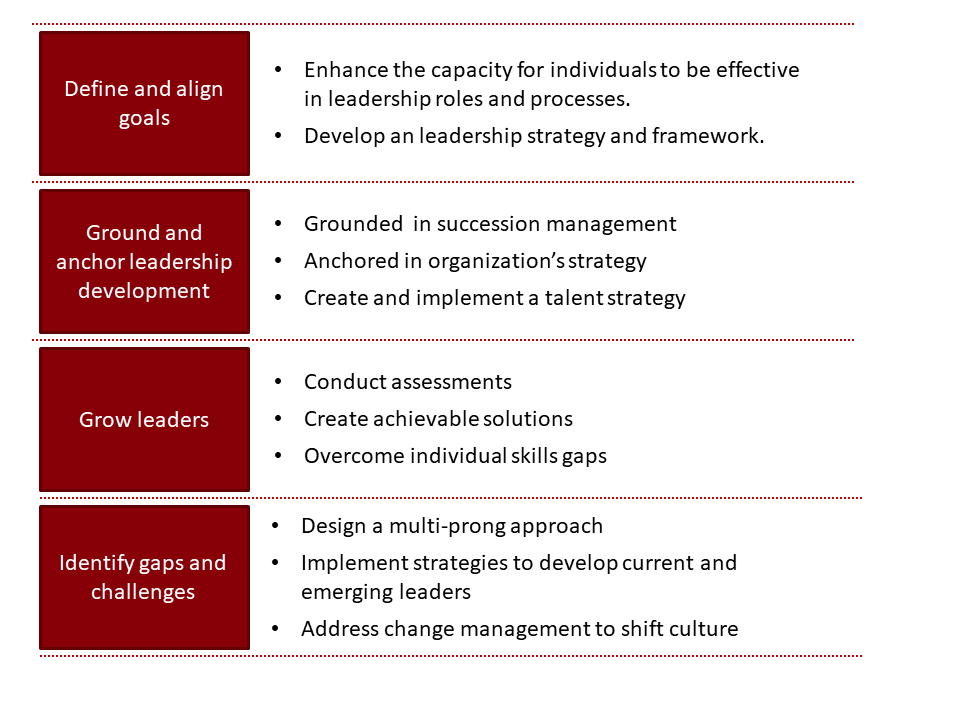|
Is your organization prepared? Bill Valdez wants to know, Is the Federal Government in the Midst of a Leadership Crisis? Using data from a survey conducted by the Senior Executives Association (SEA) in collaboration with Deloitte, he argues that a government-wide strategy to nurture the next generation of leaders doesn't exist. They are ill-prepared to address what the report refers to as a retirement tsunami. Consider these statistics:[1]
Warning Signs[6] What are the potential warning signs that your organization might be facing a leadership crisis?
Recommendations for Leadership Development Consider the following when creating a leadership development program: Leadership development may seem daunting and overwhelming, especially if an organization finds itself in the same predicament as the federal government. Ignoring the problem, relying on Talent Acquisition to continually feed the pipeline, or succumbing to paralysis is a choice that most organizations cannot afford. Invite partners across the organization to begin the discussion, create a call to action rooted in data, conduct analysis, sketch a framework and strategy, and identify actionable and achievable steps to get the ball rolling. References [1] Valdez, B., Dye, D., & Womack, K. (n.d.). Survey of federal government executives. Retrieved February 01, 2018, from https://seniorexecs.org/989-survey-of-federal-government-executives [2] Bersin, J., Geller, J., Wakefield, N., & Walsh, B. (2016, February 29). Introduction—The new organization. Retrieved January 17, 2018, from https://www2.deloitte.com/insights/us/en/focus/human-capital-trends/2016/human-capital-trends-introduction.html [3] Bersin, Introduction—The new organization. [4] Shahid, S. (2014). Outlook on the global agenda (Rep.). Retrieved January 17, 2018, from World Economic Forum website: http://www3.weforum.org/docs/GAC14/WEF_GAC14_OutlookGlobalAgenda_Report.pdf [5] The state of leadership development (Rep.). (2016). Retrieved January 17, 2018, from Harvard Business Publishing website: https://www.harvardbusiness.org/sites/default/files/19770_CL_StateOfLeadership_Report_July2016.pdf [6] Hairston Blade, V. (2017, September 18). 10 warning signs that your leadership pipeline is at risk. Retrieved January 17, 2018, from https://www.forbes.com/sites/forbescoachescouncil/2017/07/05/10-warning-signs-that-your-leadership-pipeline-is-at-risk/#6e8886a37c73 [7] (n.d.). Retrieved January 17, 2018, from https://www.criticalthinking.org/pages/defining-critical-thinking/766 [8] Kastner, N., & Somogyi, E. (2017, February 22). 5 skills employers are seeking but millennials are lacking (through the eyes of a millennial). Retrieved February 01, 2018, from http://blog.ung.edu/mba/5-skills-employers-are-seeking-but-millennials-are-lacking-through-the-eyes-of-a-millennial/ [9] American Sociological Association. (2009, March 31). Research links diversity with increased sales revenue and profits, more customers[Press release]. Retrieved May 21, 2018, from https://www.eurekalert.org/pub_releases/2009-03/asa-rld033009.php
0 Comments
|
Archives
August 2020
BlogOur clients and the training community ask us questions and often consistent themes emerge. From making learning stick to developing skills we once assumed every employee possessed, the challenges today’s businesses face can be transformed through a strong learning culture.
Every year, the learning and development industry presents exciting developments, time-saving innovations, and new research. Solutions Arts follows and tests theories, practices, and technologies, and our clients benefit from what we learn. We value sharing what we learn and the opportunity to discuss it here on our blog.
Categories |


 RSS Feed
RSS Feed